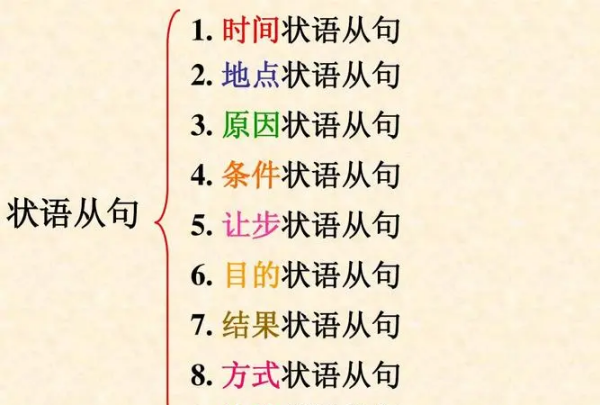本文目录
九大状语从句的省略顺口溜
状语从句有九种,时地原因条件补,目的结果方让步,连词引导各不同。主句通常前面走,连词引从紧随后。从句若在主前头,主从之间有个逗。
一、时间状语从句
常用引导词:when(在…时),as(当…时),while(在…期间),as soon as(一……就……),before(在…之前),after(在...之后),since(自从...以来), not...until(直到…才)until/till(直到…时)等
二、地点状语从句
常用引导词:where
特殊引导词:wherever, anywhere, everywhere
Wherever you go, you should work hard.
无论你去哪里,你都应该努力工作。
三、原因状语从句
常用引导词:because, since, as,
特殊引导词:seeing that, now that, in that, considering that, given that.
Now that everybody has come, let’s begin our conference.
既然每个人都到了,让我们开始我们的会议吧。
四、目的状语从句
常用引导词:so that, in order that
The teacher raised his voice on purpose that the students in the back could hear more clearly.

五、结果状语从句
常用引导词:so…that, such…that, so that...
He got up so early that he caught the first bus.
他很早起床以便赶上第一班公共汽车
六、条件状语从句
常用引导词:if, unless,whether(whether...or not)
如果总统同意,我们将开始我们的项目
七、让步状语从句
常用引导词:though, although, even if, even though
特殊引导词:as(用在让步状语从句中必须要倒装),while (一般用在句首),no matter….
Much as I respect him, I can’t agree to his proposal.
尽管我很尊敬他,但是我却不同意他的建议。
八、比较状语从句
常用引导词:as(同级比较),than(不同程度的比较)
特殊引导词:the more…the more…(越来...越...)r.
She is as bad-tempered as her mother.
她和她妈妈一样脾气很坏。
九、方式状语从句
常用引导词:as, as if
特殊引导词:the way
When in Rome, do as the Romans do.
入国问禁,入乡随俗。
状语从句有哪些类型
状语从句的类型:时间状语从句、地点状语从句、原因状语从句、目的状语从句等。
时间状语从句:凡是从句都必须有引导词,引导时间状语从句的词有when,before,after,until,assoonas,while等。
条件状语从句:主要看一下由if引导的条件状语从句。
状语从句根据其作用可分为时间、地点、原因、条件、目的、结果、让步、方式和比较等从句。状语从句一般由连词引导,也可以由词组引起。一站式出国留学攻略 ***ing.com

状语从句的9种形式口诀
状语从句的9种形式如下:
1.时间状语从句.
常用引导词:when,as,while,as soon as, before,after,since,till,untill
特殊引导词:the minute,the moment,the second,every time,the day,the instant, immediately,directly,no sooner... than, hardly... when,scarcely... when
例:No sooner had I arrived home than it began to rain.
还没到家就开始下雨了。

2.地点状语从句.
常用引导词:where
特殊引导词:wherever,anywhere, everywhere
例:Wherever you go, you should work hard.

3.原因状语从句.
常用引导词:because,since,as
特殊引导词:seeing that(由于,因为),now that(既然,由于),in that(既然,由于)considering that(考虑到……,就……而言)given that (考虑到)
例:Now that everybody has come, let's begin our conference.
状语从句的9种形式口诀
状语从句讲解
状语修饰动词、形容词、副词或整个句子.通常由副词、介词短语、动词不定式、分词和从句等担当.例如:
1.Naturally ,our grandparents were pleased to get our phone call .(副词)
2.We worked hard ,from sunrise to sunset .(介词状短语)
3.To help my disabled aunt ,I spend an hour working in her house every day .(不定式)
4.Seen from a distance ,the farmhouse looked deserted .(过去分词)
5.I know how to light a camp fire because I had done it before .(原因状语从句)
状语的位置比较灵活,可以位于句首、句末或句中.enough用作状语修饰形容词和副词时必须后置.
状语从句主要用来修饰主句或主句的谓语.一般可分为九大类,分别表示时间、地点、原因、目的、结果、条件、让步、比较和方式.尽管种类较多,但由于状语从句与汉语结构和用法相似,所以理解和掌握它并不难.状语从句的关键是要掌握引导不同状语从句的常用连接词
和特殊的连接词即考点.现分别列举如下:
1. 时间状语从句
常用引导词:when,as,while,as soon as,while,before,after,since ,till,until
特殊引导词:the minute,the moment,the second,every time,the day,the instant,immediately ,directly,no sooner … than,hardly …when,scarcely … when
I didn’t realize how special my mother was until I became an adult.
While John was watching TV,his wife was cooking.
The children ran away from the orchard(果园) the moment they saw the guard.
No sooner had I arrived home than it began to rain.
Every time I listen to your advice,I get into trouble.
2. 地点状语从句
常用引导词:where
特殊引导词:wherever,anywhere,everywhere
Generally,air will be heavily polluted where there are factories.
Wherever you go,you should work hard.
3. 原因状语从句
常用引导词:because,since,as,since
特殊引导词:seeing that,now that,in that,considering that,given that,considering that,
My friends dislike me because I’m handsome and successful.
Now that everybody has come,let’s begin our conference.
The higher income tax is harmful in that it may discourage people from trying to earn more.
Considering that he is no more than 12 years old,his height of 1.80 m is quite remarkable.
4. 目的状语从句
常用引导词:so that,in order that
特殊引导词:lest,in case,for fear that,in the hope that,for the purpose that,to the end that
The boss asked the secretary to hurry up with the letters so that he could sign them.
The teacher raised his voice on purpose that the students in the back could hear more clearly.
5. 结果状语从句
常用引导词:so … that,so… that,such … that,
特殊引导词:such that,to the degree that,to the extent that,to such a degree that,
He got up so early that he caught the first bus.
It’s such a good chance that we must not miss it.
To such an degree was he excited that he couldn’t sleep last night.
6. 条件状语从句
常用引导词:if,unless,
特殊引导词:as/so long as,only if,providing/provided that,suppose that,in case that,on condition that
We’ll start our project if the president agrees.
You will certainly succeed so long as you keep on trying.
Provided that there is no opposition,we shall hold the meeting here.
7. 让步状语从句
常用引导词:though,although,even if,even though
特殊引导词:as(用在让步状语从句中必须要倒装),while ( 一般用在句首 ),no matter …,in spite of the fact that,while,whatever,whoever,wherever,whenever,however,whichever
Much as I respect him,I can’t agree to his proposal.
尽管我很尊敬他,我却不同意他的建议.
The old man always enjoys swimming even though the weather is rough.
No matter how hard he tried,she could not change her mind.
He won’t listen whatever you may say.
8. 比较状语从句
常用引导词:as(同级比较),than(不同程度的比较)
特殊引导词:the more … the more … ; just as …,so…; A is to B what /as X is to Y; no … more than; not A so much as B
She is as bad-tempered as her mother.
The house is three times as big as ours.
The more you exercise,the healthier you will be.
Food is to men what oil is to machine.食物之于人,犹如油之于机器.
9. 方式状语从句
常用引导词:as,as if,how
特殊引导词:the way
When in Rome,do as the Roman do.
She behaved as if she were the boss.
Sometimes we teach our children the way our parents have taught us.

以上就是关于状语从句哪9种 ,九大状语从句的省略顺口溜的全部内容,以及状语从句哪9种 的相关内容,希望能够帮到您。
